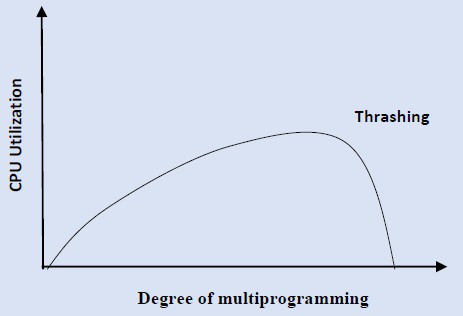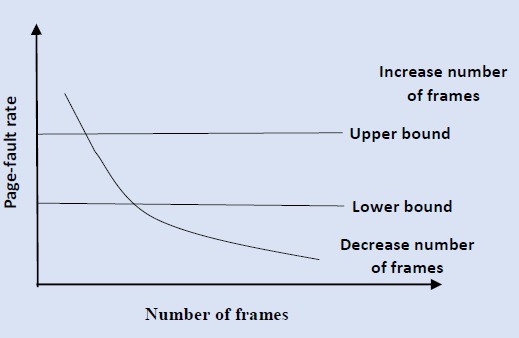1. 概述
在操作系统中,内存抖动(Thrashing) 是一个常见的性能瓶颈问题。本文将从原理、成因到解决方案,全面解析 Thrashing 的工作机制及其对系统性能的影响。
2. 什么是内存抖动(Thrashing)
操作系统使用分页机制(Paging) 将进程从磁盘加载到内存中,每个进程由多个“页(Page)”组成。
一个进程执行时至少需要一定数量的内存页帧(Frame)。如果系统分配给该进程的页帧数不足以容纳其当前活跃使用的页面,就会频繁发生缺页中断(Page Fault)。此时,进程必须替换掉某些页面,但这些页面可能很快又被访问,导致再次缺页。
这种频繁的页面换入换出行为称为 Thrashing,它会显著降低系统性能,因为 CPU 大量时间被用于页面调度,而不是执行实际任务。
3. Thrashing 的成因
当系统检测到 CPU 利用率下降时,会尝试引入更多进程以提升多道程序的并发度。如果此时某个进程需要更多页帧,它会尝试从其他进程中“抢夺”帧资源。
这会引发连锁反应:
- 被抢帧的进程也会缺页,继续抢夺其他进程的帧;
- 进程频繁缺页,导致大量 I/O 请求排队等待页面调度;
- CPU 利用率进一步下降;
- 调度器继续增加并发进程数,加剧资源竞争;
- 最终系统陷入高缺页率和低 CPU 利用率的恶性循环。
下图展示了这一过程:

4. 解决 Thrashing 的策略
4.1. 局部替换算法(Local Replacement Algorithm)
使用局部页面替换策略时,一个进程只能替换自己拥有的页面,而不会影响其他进程。这样即使某个进程发生抖动,也不会波及整个系统。
✅ 优点:防止抖动扩散
❌ 缺点:可能造成资源利用率不高
4.2. 工作集模型(Working Set Model / Locality Model)
工作集模型基于“局部性原理”(Locality Principle):进程在执行过程中会集中访问某些页面集合。
我们定义一个时间窗口 Δ,表示最近 Δ 次页面访问所使用的页面集合,这个集合称为该进程的工作集(Working Set)。
- 如果 Δ 太小,无法覆盖当前局部性区域;
- 如果 Δ 太大,可能覆盖多个局部性区域;
- 所以选择合适的 Δ 是关键。
我们为每个进程 i 计算其工作集大小 WSSi,然后求和得到总需求 D = ∑WSSi。
- 若 D > 系统可用帧数 m,就会发生 Thrashing。
系统通过监控每个进程的工作集,动态调整帧分配。若总需求超出系统资源,就挂起部分进程释放内存。
下图展示了在 Δ=9 时,进程在 t1 和 t2 时刻的工作集:

4.3. 缺页频率控制(Page Fault Frequency Strategy)
该策略通过设定缺页率的上下限来动态调整帧分配:
- 缺页率 > 上限:增加帧数;
- 缺页率 < 下限:减少帧数;
这样可以在保证性能的前提下,尽可能高效利用内存资源。
下图展示了缺页率控制的策略:

5. 总结
本文从内存抖动的基本概念出发,分析了其成因及系统层面的应对策略。内存抖动本质上是由于内存资源不足或调度策略不合理导致的恶性循环,常见于多进程并发执行的系统中。
为防止 Thrashing,可以采用以下方法:
- 使用局部页面替换策略;
- 应用工作集模型动态分配帧资源;
- 监控并控制缺页频率;
在实际系统设计中,合理配置内存资源和调度策略,是避免 Thrashing、提升系统性能的关键。